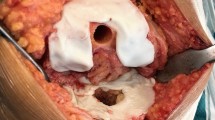Abstract
Introduction: Modern cementing technique demands high intramedullar cement pressure to create an optimum fixed cement support of the femoral stem. Pressure resistant, stable closure of the canal therefore is absolutely necessary. Biodegradable cement restrictors, if corresponding to above mentioned attributes, could be of immense advantage in case of potential revision surgery. Material and methods: A prospective, randomized trial was performed on a consecutive series of 130 patients who underwent primary cemented total hip arthroplasty due to hip arthrosis to compare a degradable cement restrictor and a non-degradable cement restrictor in their ability to resist distal migration during stem insertion. Results: The median cement plug length measured 27 mm (range −12 to 126 mm, 95% confidence interval (CI) 20–33 mm) in the biodegradable restrictor group and 15 mm (range 0–61 mm, 95% CI 12–18 mm) in the non-degradable restrictor group (P=0.003). A significant effect of the relationship between the difference of restrictor size and the diameter of the femoral canal on length of cement distal of the tip of the stem in between the two groups was evident (P=0.031). Conclusion: The results indicate insufficient intramedullary plug fixation of the degradable restrictor probably due to the elastic material properties which also may lead to inferior precision in restrictor size choice.



Similar content being viewed by others
References
Askew MJ, Steege JW, Lewis JL, Ranieri JR, Wixson RL (1984) Effect of cement pressure and bone strength on polymethylmethacrylate fixation. J Orthop Res 1(4):412–420
Bahr W, Stricker A, Gutwald R, Wellens E (1999) Biodegradable osteosynthesis material for stabilization of midface fractures: experimental investigation in sheep. J Craniomaxillofac Surg 27(1):51–57
Barrack RL, Mulroy RD Jr, Harris WH (1992) Improved cementing techniques and femoral component loosening in young patients with hip arthroplasty. A 12-year radiographic review. J Bone Joint Surg Br 74(3):385–389
Bostman O, Hirvensalo E, Makinen J, Rokkanen P (1990) Foreign-body reactions to fracture fixation implants of biodegradable synthetic polymers. J Bone Joint Surg Br 72(4):592–596
Bostman OM (1991) Osteolytic changes accompanying degradation of absorbable fracture fixation implants. J Bone Joint Surg Br 73(4):679–682
Bulstra SK, Geesink RG, Bakker D, Bulstra TH, Bouwmeester SJ, van der Linden AJ (1996) Femoral canal occlusion in total hip replacement using a resorbable and flexible cement restrictor. J Bone Joint Surg Br 78(6):892–898
Claes L, Ignatius A (2002) Development of new, biodegradable implants. Chirurg 73(10):990–996
Freund KG, Herold N, Rock ND, Riegels-Nielsen P (2003) Poor results with the Shuttle Stop: resorbable versus nonresorbable intramedullar cement restrictor in a prospective and randomized study with a 2-year follow-up. Acta Orthop Scand 74(1):37–41
Goodman SB, Fornasier VL, Kei J (1988) The effects of bulk versus particulate polymethylmethacrylate on bone. Clin Orthop 232:255–262
Hile DD, Doherty SA, Trantolo DJ (2004) Prediction of resorption rates for composite polylactide/hydroxylapatite internal fixation devices based on initial degradation profiles. J Biomed Mater Res 71B(1):201–205
Hungerford DS, Krackow KA (1981) A convenient distal plug for the femoral cavity in total hip arthroplasty. Clin Orthop 154:329–330
Ignatius AA, Claes LE (1996) In vitro biocompatibility of bioresorbable polymers: poly(l, dl-lactide) and poly(l-lactide-co-glycolide). Biomaterials 17(8):831–839
Johnson JA, Johnston D el, Hawary R, Tan SR, Wong LA, Gross M (1995) Occlusion and stability of synthetic femoral canal plugs used in cemented hip arthroplasty. J Appl Biomater 6(3):213–218
Kristiansen B, Jensen JS (1985) Biomechanical factors in loosening of the Stanmore hip. Acta Orthop Scand 56(1):21–24
Lindberg HO, Carlsson AS (1983) Mechanical loosening of the femoral component in total hip replacement, Brunswik design. Acta Orthop Scand 54(4):557–561
Malchau H, Herberts P, Ahnfelt L (1993) Prognosis of total hip replacement in Sweden. Follow-up of 92,675 operations performed 1978–1990. Acta Orthop Scand 64(5):497–506
Maltry JA, Noble PC, Kamaric E, Tullos HS (1995) Factors influencing pressurization of the femoral canal during cemented total hip arthroplasty. J Arthroplasty 10(4):492–497
Markolf KL, Amstutz HC (1976) In vitro measurement of bone-acrylic interface pressure during femoral component insertion. Clin Orthop 121:60–66
Mjoberg B (1997) The theory of early loosening of hip prostheses. Orthopedics 20(12):1169–1175
Murray DW, Rushton N (1990) Macrophages stimulate bone resorption when they phagocytose particles. J Bone Joint Surg Br 72(6):988–992
Noble PC, Alexander JW, Lindahl LJ, Yew DT, Granberry WM, Tullos HS (1988) The anatomic basis of femoral component design. Clin Orthop 235:148–165
Northmore-Ball MD, Narang OV, Vergroesen D (1991) Distal femoral plug migration with cement pressurization in revision surgery and a simple technique for its prevention. J Arthroplasty 6(3):199–201
Oh I, Carlson CE, Tomford WW, Harris WH (1978) Improved fixation of the femoral component after total hip replacement using a methacrylate intramedullary plug. J Bone Joint Surg Am 60(5):608–613
Rokkanen PU, Bostman O, Hirvensalo E, Makela EA, Partio EK, Patiala H, Vainionpaa SI, Vihtonen K, Tormala P (2000) Bioabsorbable fixation in orthopaedic surgery and traumatology. Biomaterials 21(24):2607–2613
Williams DF (1992) Mechanisms of biodegradation of implantable polymers. Clin Mater 10(1–2):9–12
Wroblewski BM, van der Rijt A (1984) Intramedullary cancellous bone block to improve femoral stem fixation in Charnley low-friction arthroplasty. J Bone Joint Surg Br 66(5):639–644
Yee RD, Newton CW, Patterson SS, Swartz ML (1984) The effect of canal preparation on the formation and leakage characteristics of the apical dentin plug. J Endod 10(7):308–317
Acknowledgments
The authors thank Markus Ertl for his work on the statistics section of this article. The authors declare that the study complies with the current laws of the Republic of Austria.
Author information
Authors and Affiliations
Corresponding author
Rights and permissions
About this article
Cite this article
Schauss, S.M., Hinz, M., Mayr, E. et al. Inferior stability of a biodegradable cement plug. Arch Orthop Trauma Surg 126, 324–329 (2006). https://doi.org/10.1007/s00402-006-0132-7
Received:
Published:
Issue Date:
DOI: https://doi.org/10.1007/s00402-006-0132-7




